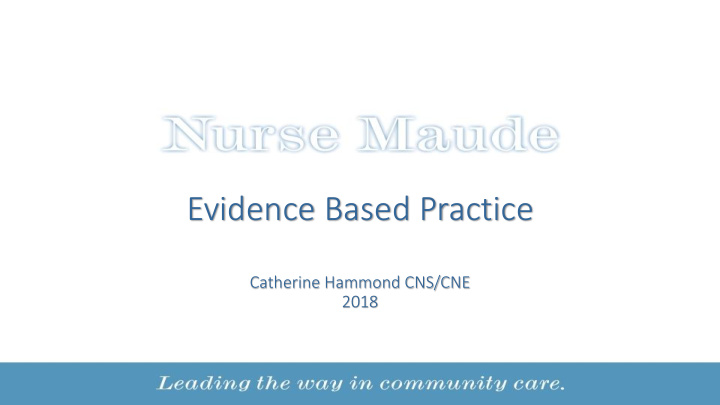



Evidence Based Practice Catherine Hammond CNS/CNE 2018
Is your clinical practice evidenced based?
What is Evidence Based Practice EBP? The practice that involves making clinical decisions on the best available evidence, with an emphasis on evidence from disciplined research
Type of research Quantitative Qualitative
Hierarchy of evidence
Randomised controlled trials • Who conducted the research? • Animal, people, in-vivo or in-vitro • Size of the study • Randomisation • Were arms of study equal • Blinding/non blinded • Were all patients accounted for? • Is your population similar to that of the study • Number needed to treat NNT
Systematic reviews • Synthesis of results related to a research question • Usually RCT’s • Using peer reviewed SR - Cochrane systematic reviews • Check for rigor – what studies were included
Other types of studies Cohort studies Case controlled studies • Group of patients identified • Select a group of patients with a disease eg VLU • Patients are followed up at a • Compared to group of patients later time without the disease • Retrospective study Cross-sectional studies • A patient group are looked at at one point – prevalence study • Provide a snapshot of a population
Qualitative studies • Provides insights into a problem • Opinions • Interviews • Focus groups • Emerging themes • Eg the lived experience with a leg ulcer
Who has time to assess research?
Where does your evidence come from? • That’s the way we do it here • That has worked before so …. • I picked this up on a seminar • Mr Google or You tube • In a peer review journal • The company representative • Local guidelines • Clinical practice guidelines • Reviewed the literature
Venous Leg Ulcer Guideline • Expert team from AWMA and NZWCS • Reviewed best evidence: systematic reviews RCTs • Recommendations • Practice points • Full , abridged versions • Flow chart and pt literature
Expert opinion • Consensus documents • Based on expert opinion • Review and discuss clinical experiences and the scientific evidence where this is available • Check for peer review
Where does clinical judgement and innovation fit?
Clinical practice does not stand still
Summation • There is no one way to keep up-dated • Question practice • Use your resources – journals, guidelines, expert clinicians, • Use your clinical judgement wisely • We aware of what you don’t know • Remain open minded – question and challenge
References AWMA & NZWCS. (2011). Australian and New Zealand clinical practice guideline for prevention and management of venous leg ulcers. Austraila, Cambridge publishing. Crombie, I. (2000). The pocket guide to critical appraisal . Plymouth, England, BMJ. European Wound Management Association. (2010). Outcomes in controlled and comparative studies on non-healing wounds. EWMA patient outcome group document. Journal Wound Care. Green, J., Jester, R., McKinley, R., & Pooler, A. (2014). The impact of chronic venous leg ulcers: a systematic review. Journal of Wound Care, 23 (12),601-12 Polit, D. & Beck, C. (2008). Nursing Research: Generating and assessing evidence for nursing practice. Philadelphia, USA, Lippincott Williams & Wilkins.
Recommend
More recommend